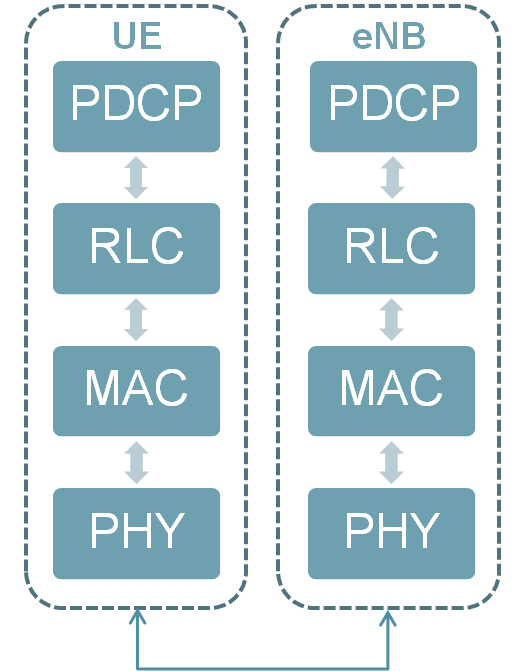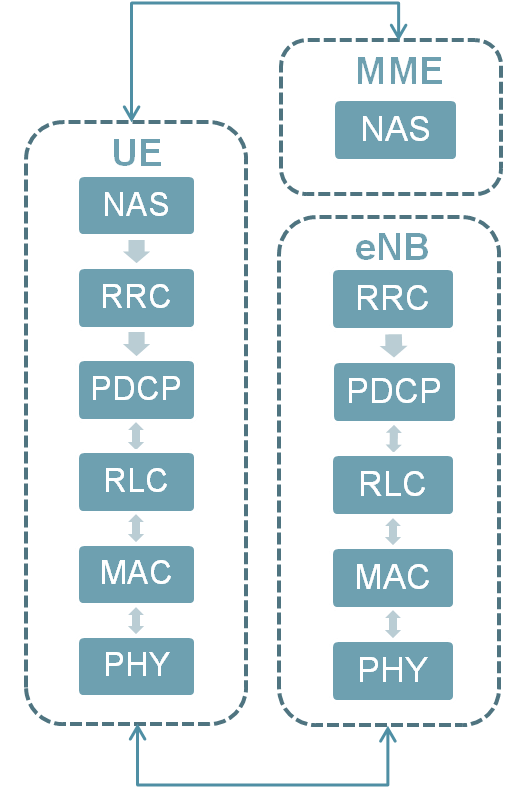User Plane Protocols
The architecture of the user plane in LTE can be described by the figure bellow:
 Figure: User Plane Protocol Stack
Packet Data Convergence Protocol (PDCP): This protocol is responsible for processing the IP packets, compressing and decompressing the header. It performs handover support functions, security functions and discards for the user plane due to timeout.
Radio Link Control (RLC): This layer is responsible for the segmentation and concatenation of the IP packets. In some cases it can also perform retransmission to recover from packet losses. The functions of the RLC layer are performed by “RLC entities”.
Medium Access Control (MAC): This layer is responsible for the mapping the logical channels into the transport channels. It consists in a HARQ entity to transmit and receive HARQ operations, a multiplexing/demultiplexing entity, a logical channel prioritization entity, a random access control entity and a controller.
Figure: User Plane Protocol Stack
Packet Data Convergence Protocol (PDCP): This protocol is responsible for processing the IP packets, compressing and decompressing the header. It performs handover support functions, security functions and discards for the user plane due to timeout.
Radio Link Control (RLC): This layer is responsible for the segmentation and concatenation of the IP packets. In some cases it can also perform retransmission to recover from packet losses. The functions of the RLC layer are performed by “RLC entities”.
Medium Access Control (MAC): This layer is responsible for the mapping the logical channels into the transport channels. It consists in a HARQ entity to transmit and receive HARQ operations, a multiplexing/demultiplexing entity, a logical channel prioritization entity, a random access control entity and a controller.
 Figure: User Plane Protocol Stack
Packet Data Convergence Protocol (PDCP): This protocol is responsible for processing the IP packets, compressing and decompressing the header. It performs handover support functions, security functions and discards for the user plane due to timeout.
Radio Link Control (RLC): This layer is responsible for the segmentation and concatenation of the IP packets. In some cases it can also perform retransmission to recover from packet losses. The functions of the RLC layer are performed by “RLC entities”.
Medium Access Control (MAC): This layer is responsible for the mapping the logical channels into the transport channels. It consists in a HARQ entity to transmit and receive HARQ operations, a multiplexing/demultiplexing entity, a logical channel prioritization entity, a random access control entity and a controller.
Figure: User Plane Protocol Stack
Packet Data Convergence Protocol (PDCP): This protocol is responsible for processing the IP packets, compressing and decompressing the header. It performs handover support functions, security functions and discards for the user plane due to timeout.
Radio Link Control (RLC): This layer is responsible for the segmentation and concatenation of the IP packets. In some cases it can also perform retransmission to recover from packet losses. The functions of the RLC layer are performed by “RLC entities”.
Medium Access Control (MAC): This layer is responsible for the mapping the logical channels into the transport channels. It consists in a HARQ entity to transmit and receive HARQ operations, a multiplexing/demultiplexing entity, a logical channel prioritization entity, a random access control entity and a controller.
Control Plane Protocols
The architecture of the user plane in LTE can be described by the figure bellow:
 Figure: Control Plane Protocol Stack
Packet Data Convergence Protocol (PDCP): This protocol is responsible for processing the IP packets, compressing and decompressing the header. It performs handover support functions, security functions and discards for the user plane due to timeout.
Radio Link Control (RLC): This layer is responsible for the segmentation and concatenation of the IP packets. In some cases it can also perform retransmission to recover from packet losses. The functions of the RLC layer are performed by “RLC entities”.
Medium Access Control (MAC): This layer is responsible for the mapping the logical channels into the transport channels. It consists in a HARQ entity to transmit and receive HARQ operations, a multiplexing/demultiplexing entity, a logical channel prioritization entity, a random access control entity and a controller.
Figure: Control Plane Protocol Stack
Packet Data Convergence Protocol (PDCP): This protocol is responsible for processing the IP packets, compressing and decompressing the header. It performs handover support functions, security functions and discards for the user plane due to timeout.
Radio Link Control (RLC): This layer is responsible for the segmentation and concatenation of the IP packets. In some cases it can also perform retransmission to recover from packet losses. The functions of the RLC layer are performed by “RLC entities”.
Medium Access Control (MAC): This layer is responsible for the mapping the logical channels into the transport channels. It consists in a HARQ entity to transmit and receive HARQ operations, a multiplexing/demultiplexing entity, a logical channel prioritization entity, a random access control entity and a controller.
 Figure: Control Plane Protocol Stack
Packet Data Convergence Protocol (PDCP): This protocol is responsible for processing the IP packets, compressing and decompressing the header. It performs handover support functions, security functions and discards for the user plane due to timeout.
Radio Link Control (RLC): This layer is responsible for the segmentation and concatenation of the IP packets. In some cases it can also perform retransmission to recover from packet losses. The functions of the RLC layer are performed by “RLC entities”.
Medium Access Control (MAC): This layer is responsible for the mapping the logical channels into the transport channels. It consists in a HARQ entity to transmit and receive HARQ operations, a multiplexing/demultiplexing entity, a logical channel prioritization entity, a random access control entity and a controller.
Figure: Control Plane Protocol Stack
Packet Data Convergence Protocol (PDCP): This protocol is responsible for processing the IP packets, compressing and decompressing the header. It performs handover support functions, security functions and discards for the user plane due to timeout.
Radio Link Control (RLC): This layer is responsible for the segmentation and concatenation of the IP packets. In some cases it can also perform retransmission to recover from packet losses. The functions of the RLC layer are performed by “RLC entities”.
Medium Access Control (MAC): This layer is responsible for the mapping the logical channels into the transport channels. It consists in a HARQ entity to transmit and receive HARQ operations, a multiplexing/demultiplexing entity, a logical channel prioritization entity, a random access control entity and a controller.